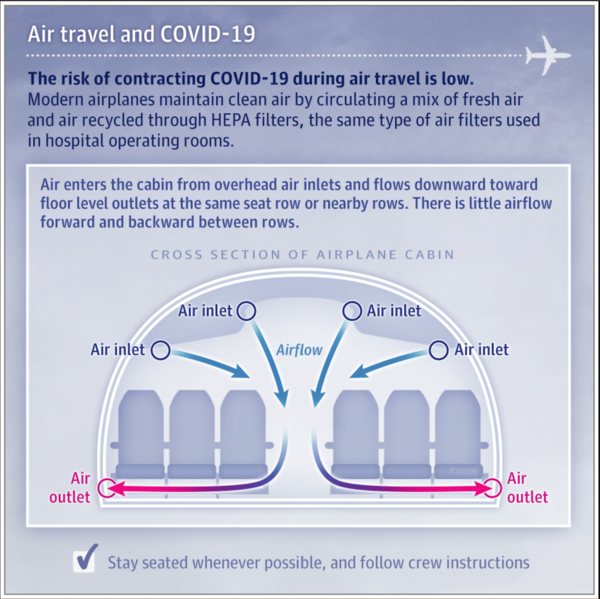The risk of contracting coronavirus disease 2019 (COVID-19) during air travel is lower than from an office building, classroom, supermarket, or commuter train.
The virus that causes COVID-19 is emitted when someone talks, coughs, sneezes, or sings, mainly in droplets that can be propelled a short distance, and sometimes in smaller aerosol particles that can remain suspended and travel further. Another person can be infected if these particles reach their mouth or nose, directly or via hands. Transmission via surface contact is also important in some cases.
Air enters the cabin from overhead inlets and flows downwards toward floor-level outlets. Air enters and leaves the cabin at the same seat row or nearby rows. There is relatively little airflow forward and backward between rows, making it less likely to spread respiratory particles between rows.
The airflow in current jet airliners is much faster than normal indoor buildings. Half of it is fresh air from outside, the other half is recycled through HEPA filters of the same type used in operating rooms. Any remaining risk to be managed is from contact with other passengers who might be infectious. Seat backs provide a partial physical barrier, and most people remain relatively still, with little face-to-face contact.
Despite substantial numbers of travelers, the number of suspected and confirmed cases of in-flight COVID-19 transmission between passengers around the world appears small (approximately 42 in total). In comparison, a study of COVID-19 transmission aboard high-speed trains in China among contacts of more than 2300 known cases showed an overall rate of 0.3% among all passengers. Onboard risk can be further reduced with face coverings, as in other settings where physical distancing cannot be maintained.
Steps being taken at airports and on board can include temperature testing and/or asking about symptoms (fever, loss of sense of smell, chills, cough, shortness of breath); enhanced cleaning and disinfection; contactless boarding/baggage processing; use of physical barriers and sanitization in airports; physical distancing in airports and during boarding; use of face coverings or masks; separation between passengers on board when feasible; adjustment of food and beverage service to reduce contact; control of access to aisles and bathrooms to minimize contact; limiting exposure of crew members to infection; and facilitation of contact tracing in the event that a passenger develops infection.
Additional steps being studied are preflight testing for COVID-19 and adjustments to quarantine requirements.
Wear a mask, don't travel if you feel unwell, and limit carry-on baggage. Keep distance from others wherever possible; report to staff if someone is clearly unwell. If there is an overhead air nozzle, adjust it to point straight at your head and keep it on full. Stay seated if possible, and follow crew instructions. Wash or sanitize hands frequently and avoid touching your face.
空の旅でのCOVID-19の感染リスクは、オフィスビルや教室、スーパー、通勤電車などによる移動よりも低いとされています。
COVID-19の原因となるウイルスは、誰かが話したり、咳をしたり、くしゃみをしたり、歌ったりしたときに放出されますが、主に短距離を進む飛沫で、時には浮遊したままでより遠くへ移動できる小さなエアロゾル粒子で放出されます。これらの粒子が他の人の口や鼻に直接、または手を介して到達すると、その人が感染することがあります。場合によっては、接触感染も重要です。
空気は頭上の吸気口から機内に入り、フロアレベルの吸気口に向かって下に流れていきます。空気は、座席の同じ列またはその近くの列から出入りします。列の間の前後の気流は比較的少なく、列の間で呼吸器系の粒子が拡散する可能性は低くなっています。
現在のジェット旅客機の空気の流れは、通常の屋内の建物よりもはるかに速くなっています。その半分は外部からの新鮮な空気で、残りの半分は手術室で使用されているのと同じタイプのHEPAフィルターを通して再利用されています。管理すべき残りのリスクは、感染の可能性のある他の乗客との接触によるものです。背もたれは部分的な物理的バリアとなり、ほとんどの乗客は比較的じっとしていて、顔と顔を合わせて接触することはほとんどありません。
かなりの数の旅行者がいるにもかかわらず、世界中の乗客間でのCOVID-19感染の疑い例および確認例は少ないようです(合計で約42例)。これと比較して、中国の高速列車内でのCOVID-19感染の調査では、2300人以上の既知の感染者との接触の中で、全乗客の0.3%がCOVID-19に感染していることがわかりました。機内でのリスクは、物理的な距離を保つことができない他の状況と同様に、顔を覆うことでさらに低減することができます。
空港や機内で行われている対策としては、体温測定や症状(発熱、嗅覚の低下、悪寒、咳、息切れ)の確認、清掃・消毒の強化、非接触による搭乗・手荷物処理、空港内での物理的バリアの使用と消毒、空港内や搭乗中での物理的な距離の確保、フェイスカバーやマスクの使用、可能な場合は乗客同士の距離の確保、接触を減らすための飲食サービスの調整、接触を最小限に抑えるための通路やトイレへのアクセスの管理、乗務員の感染への曝露の制限、乗客が感染症を発症した場合の接触者追跡の容易化などが行われています。
その他のステップとして、COVID-19のフライト前検査と検疫要件の調整が検討されています。
マスクを着用し、気分が悪いと感じたら旅行しないようにし、機内持ち込み手荷物を制限する。明らかに気分が悪そうな人がいる場合はスタッフに報告してください。頭上にエアノズルがある場合は、自分の頭部へ真っ直ぐ吹き付けるように調節し、フル稼働させたままにしてください。可能であれば座ったままで、乗務員の指示に従ってください。頻繁に手を洗うか消毒し、顔に触れないようにしてください。

https://jamanetwork.com/journals/jama/fullarticle/2771435